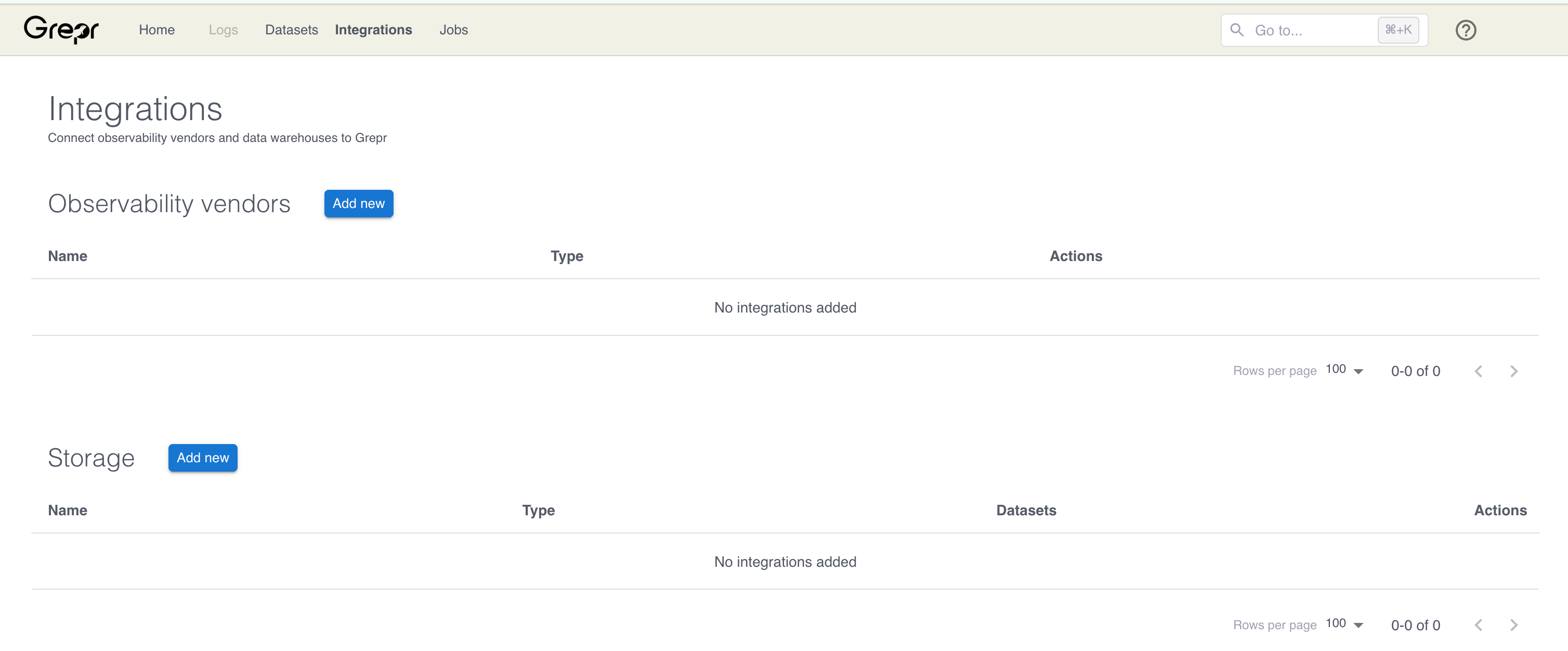Sumo Logic
Sumo Logic integrations are supported in both the UI and the API.
Grepr supports integrating with SumoLogic via Sumo Logic’s OTLP/HTTP source
Server logs
To send data to Grepr, you configure the collectors to send logs to Grepr instead of Sumo Logic. This involves changing the logging endpoint in the collector forwarding logs to Sumo Logic.
The endpoint that you need to configure has the following format:
https://<integration-id>-<org-id>.ingest.grepr.ai/otlp/{$GREPR_TOKEN}. The Grepr UI makes it available for
copying in the Sources section of the pipeline details page. Otherwise, the
integration-id is the ID of the Sumo Logic integration that you’d like to use, available via the
API.
Your GREPR_TOKEN will be the same string at the end of the Sumo Logic Source URL that you provide Grepr when creating the integration.
Creating a Sumo Logic Integration in Grepr
To create a Sumo Logic integration in Grepr, follow the steps below:
- Navigate to the Integrations page in the Grepr UI. In the Observability Vendors section, click the Add New button.

-
Select Sumo Logic from the list of vendors.
-
Enter a Name for the integration. We recommend naming it after the data collector it will be used with (e.g.,
prod-k8s-collector) so that the URL can be looked up in Sumo Logic if needed. -
Enter the HTTP Source URL that your collectors are currently configured to use.
OpenTelemetry Collector
The OpenTelemetry Collector can send logs to Grepr using the sumologic exporter, which is available in the otel/opentelemetry-collector-contrib distribution.
Configure the exporter to point to Grepr’s ingestion endpoint.
Configuration (collector.yaml):
exporters:
sumologic:
endpoint: <grepr-ingestion-url>
log_format: otlp
service:
pipelines:
logs:
exporters: [sumologic]Replace <grepr-ingestion-url> with the full ingestion URL provided by the Grepr UI.
To configure dual shipping create two exporters, one being sumologic/grepr this using the Grepr ingestion URL, and the other being sumologic/direct using the Sumo Logic endpoint.
Configuration (collector.yaml):
exporters:
sumologic/grepr:
endpoint: <grepr-ingestion-url>
log_format: otlp
sumologic/direct:
endpoint: <sumologic-http-source-address>
log_format: otlp
service:
pipelines:
logs:
exporters: [sumologic/grepr, sumologic/direct]Replace <sumologic-source-url> with the URL
For more information on the Sumo Logic exporter, see the OpenTelemetry Collector Contrib documentation .
OpenTelemetry Collector Helm Chart
If you are deploying the collector in Kubernetes using the official OpenTelemetry Collector Helm Chart ,
you can update your values.yaml to point to the otlphttp exporter to Grepr.
Configuration (values.yaml):
config:
exporters:
otlphttp:
endpoint: <grepr-ingestion-url>
service:
pipelines:
logs:
exporters: [otlphttp]To configure dual shipping create two exporters, one being otlphttp/grepr this using the Grepr ingestion URL, and the other being otlphttp/sumologic using the Sumo Logic endpoint.
config:
exporters:
otlphttp/grepr:
endpoint: <grepr-ingestion-url>
otlphttp/sumologic:
endpoint: <sumologic-http-source-address>
service:
pipelines:
logs:
exporters: [otlphttp/grepr, otlphttp/sumologic]Fluent Bit
If you are using fluent-bit to send logs to SumoLogic, you can update it to send them to Grepr by using its opentelemetry output plugin. You will need to update the Host to match the host of the Grepr Ingestion URL provided in the UI.
Configuration (fluent-bit.conf):
[OUTPUT]
Name opentelemetry
Match *
Host <hostname-from-grepr-ingest-url>
Port 443
tls On
Logs_uri YOUR_LOGS_URI<hostname-from-grepr-ingest-url>the hostname from your Grepr ingestion URL (e.g.,<integration-id>-<org-id>.ingest.grepr.ai).
For more information please see Fluent Bit OpenTelemetry Output Documentation .